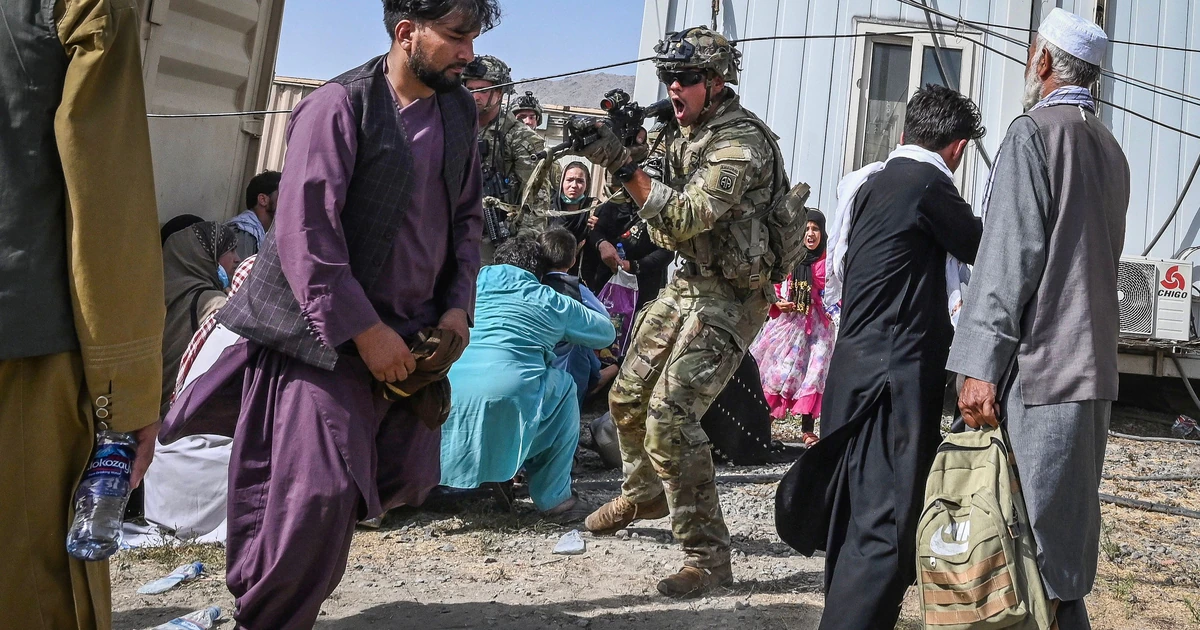
Maj. Gen. Chris Donahue, the commander of the 82nd Airborne Division, is heading to Kabul, Afghanistan, to oversee the U.S. troops who have secured the airfield at Hamid Karzai International Airport to facilitate the evacuation of people fleeing the Taliban, the Pentagon confirmed Tuesday morning.
Although overall leadership of U.S. forces in Afghanistan still rests with U.S. Forces Afghanistan Forward commander Rear Adm. Peter Vasely, Donahue and his staff will take over airfield security operations.
“[Maj. Gen.] Donahue and a piece of his staff will go forward and work specifically on the security mission at [the airport],” said Army Maj. Gen. Henry Taylor, the Pentagon’s director of current operations.
“The task of securing and operating an airfield is actually a unique task that the 82nd can do, and [Maj. Gen.] Donahue has experience in that” explained Pentagon spokesperson John Kirby in a Tuesday morning press conference. “[Rear Adm.] Vasely, who has been commanding on the ground, also has a spate of other duties…to include liaison with the State Department, our allies and partners.”
“There’s a lot of things to do, so we felt like this division of labor made the most sense,” Kirby said.
Once the rapid deployment is complete, elements of the 82nd Airborne’s division headquarters and three of its infantry battalions will be on site, in addition to two Marine infantry battalions and an Army National Guard-led combined arms battalion. Approximately 7,000 troops will be at the airport once all of the units are in place, Kirby said Monday.
For now, an uneasy truce is holding between the Taliban fighters in Kabul and the Americans at the airport, Kirby said.
“Our commanders at the airport are in communication with Taliban commanders on the ground outside the airport,” Kirby said. “There’s been no hostile interactions from the Taliban…[but] we’re not taking anything for granted.”
Kirby declined to elaborate on the extent or scope of the discussions between U.S. commanders and the Taliban, but said that “the results speak for themselves so far.”
Why Donahue and the 82nd Airborne?
Kirby’s statements at the press conference are indicative of a larger historical trust placed on the 82nd Airborne Division to seize, secure, and operate airfields when necessary.
The Army’s doctrine for airborne operations centers around “forcible entry,” whereby an airborne unit with Air Force support fights its way into a denied area and sets the stage for other units to follow. Often, forcible entry exercises include seizing an airfield, securing it, and setting it up for additional forces to arrive via its airstrip.
During Operation Just Cause, the U.S. invasion of Panama in 1989, approximately 2,000 82nd paratroopers from the Fort Bragg, North Carolina-based division joined Army Rangers to seize and secure Torrijos International Airfield.
To this day, the 82nd frequently rehearses airfield security and operations as part of its specialized skillset.
The division’s 3rd Brigade simulated an airfield seizure alongside Brazilian troops in a training rotation at the Joint Readiness Training Center at Fort Polk, Louisiana in February.
And hundreds more participated in a similar operation alongside European counterparts in May as part of Swift Response 21.
Troops from the division’s 2nd Brigade practiced it in Colombia in January 2020, too.
The division also maintains an “Immediate Response Force” of approximately an infantry brigade — 3,000 to 4,000 soldiers — on alert to deploy worldwide with minimal notice. Although Defense Department officials have not specified which units are deploying to Kabul, the three battalions moving to secure the airport are likely part of whichever one of the division’s brigades is currently tabbed with the IRF mission.
When the 82nd’s 1st Brigade Combat Team deployed in response to spiraling tensions with Iran in December 2019, the first 650 troops were boarding planes on less than 18 hours’ notice.
“This is what the 82nd Airborne does really well,” Kirby said.
And in addition to the unit’s suitability for the mission, Donahue has recent operational experience in Afghanistan.
In his prior assignment before taking division command, Donahue served as the commander of Special Operations Joint Task Force-Afghanistan, which formerly oversaw special operations missions across the country from its headquarters at Bagram Airfield. In that role, he also oversaw the special operations forces of NATO allies in Afghanistan.
The continuing evacuation
By the end of the day Tuesday, approximately 4,000 U.S. troops will be at the airport facilitating the evacuation, Taylor said.
The goal is to have an aircraft load and depart each hour, the joint staff operations director explained.
Roughly 1,500 people have been evacuated since Saturday, Taylor told reporters.
U.S. troops have cleared the crowds that were pictured on the tarmac in recent days, but Taylor did not specify how many evacuees remain at the airport.
Military Times Pentagon Bureau Chief Meghann Myers contributed to this report.



Be the first to comment